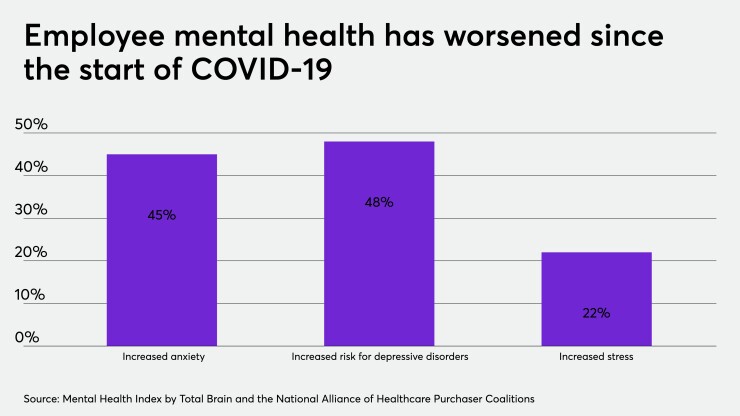Organizations have been tasked with navigating the minefield of
Almost half of employees say they have been struggling with a mental health issue during COVID-19, according to insurance company The Standard. Managers themselves are struggling too: 59% say
As remote work blurs the line between professional and private life, managers have been encouraged to share their own challenges with employees, in an effort to connect with them and alleviate their stress. However, there’s a fine line leaders should learn to tow, says Gail Golden, an organizational psychologist and author of
“Everyone is talking about bringing your whole self to work and authenticity in the workplace — I’m not a fan of that,” Golden says. “There are pieces of ourselves that don't belong in the workplace. When you're a leader, all your fears, all your anxieties, all your self doubt — it’s not smart to share all that stuff.”
Just half of employees feel comfortable discussing mental health at work and one-third of employees are concerned about the job consequences of seeking care, according to the American Psychiatric Association. But mental health issues have a direct impact on
Read more:
When navigating these scenarios, leaders need to be hyper-aware of their role, Golden says. If a manager witnesses warning signs, like poor work performance or a change in appearance, Golden recommends they focus on how to help employees improve their quality of work before probing into their emotional state.
“Very few people in management are qualified mental health professionals,” Golden says. “It’s not their job to treat people who work for them or to be a therapist for someone who works for them. The goal here is to enable the person to return to good health and good productivity.”
Managers can simply ask, “What’s going on?” to give an employee the opportunity to share, Golden says. Then they can guide employees to available resources like an
Managers shouldn’t ask about what is making employees depressed or what their symptoms are, Golden says. Instead, the focus should be on the worker. Managers should express concern and offer guidance.
Read more:
Sometimes, a manager may feel that divulging their own issues may help them appear more relatable and sympathetic to employees, but they need to think carefully about their end goal, Golden says.
“As a manager, if I’m going to share something about myself in the workplace, I need to be thoughtful about why,” Golden says. “Am I doing it because sharing is going to be helpful to that person, or am I doing it because I feel like talking about it and dealing with my pain? Managers need to be very conscious of what they're choosing to share because that will set the tone for the rest of the group.”






